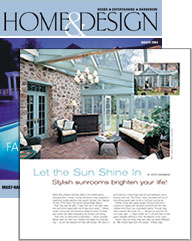 LET THE SUN SHINE IN
LET THE SUN SHINE IN
Stylish sunrooms brighten your life!
by Joyce Eisenberg
When Rory O’Brien and Don Wilkins first talked about enlarging their Chester County farmhouse, they imagined a traditional roofed addition that would maintain the integrity of their 1750 home, the former Spread Eagle Tavern. Then they saw the light. “I said, ‘Let’s go in the other direction and build a space with lots of glass and wood,” says Rory O’Brien says, recalling how she would put away the porch furniture each winter and gaze longingly at the terrace until spring.
Their new sun-drenched conservatory – which provides elbow room for their four children and space for entertaining – sits on the footprint of their old terrace. The room is anchored by a 3-foot-high wall of local fieldstone and a sloping shed roof. The French doors, windows and six of the ceiling panels open to let in the fresh country air.
O’Brien chose dark green wicker furniture with print cushions to replace the old porch furniture and the new cobbled brick floor has a wonderful patina. Though they have a plasma flat-screen TV – “we got our very first TV just a year ago” – they’d rather turn it off and listen to the piano playing drifting in from the adjacent music room.
There’s only one thing they wished they did differently: “We should have built this sooner,” O’Brien says.
Simple or sumptuous
The O’Brien/Wilkins clan is one of 500,000 American families who add a sunroom to their home each year, according to Qualified Remodeler Magazine. For most of us, a sunroom is a space with windows and skylights that lets in the sunlight and keeps out the elements, but those in the business note the distinctions: from a screened-in porch to a three-season sunroom with single-pane glass (there’s not enough insulation to keep out the winter chill) to a year-round thermal-glass sunroom made of prefabricated modules.
At the top of the pecking order is a custom-built traditional conservatory, with English style, South American wood and French shades. The world’s most visited conservatory is the Musee de’ l’Orangerie in Paris, an impressionist art museum on the terrace of the Tuileries Gardens; the most famous is London’s Crystal Palace, built in 1851 for the world’s first international exposition.
The price tag for your sunny space can be dazzling, from $12,000 to $15,000 for a simple patio enclosure on a 12×16 foot concrete foundation to $500,000 for a Victorian-style Orangery, reminiscent of the Musee de l’Orangerie, with ridge cresting, transom bands, etched glass and French doors.
But no matter how we let the sun shine in, one thing is certain: The sun makes us feel good. Each year, we spend more on tanning salons and winter trips to beach resorts. We buy light therapy boxes to lift our winter depression and build sunrooms at nursing homes to brighten the residents’ spirits.
To build their sunroom, O’Brien and Wilkins hired Renaissance Conservatories of Leola, PA, a company that designs, and manufactures period conservatories and contemporary solariums. The conservatories are built in sections by apprentice-trained craftsmen and then assembled on site. Just about every component can be customized.
“We call the conservatory the ‘green room’ because I chose cedro, or South American mahogany, in a soft green color for it,” O’Brien says. Mark Barocco, president of sales and marketing for Renaissance Conservatories, explains that his company also uses other premium hardwoods, such as Honduras mahogany, western red cedar, cypress and teak.
“We look at the needs of our clients, consider the home’s latitude, the room’s orientation to the sun, the available shade and how the family will use the space,” Barocco says. “We help them select the type and amount of glass and a good heating and cooling system so it’s a functional living space.”
Glass options might include triple pane glazing, which has two insulating spaces between the panes and windows filled with argon gas, which has a thermal conductivity that’s 30 percent lower than regular air.
The O’Brien/Wilkins family put radiant heat beneath their brick floor “so we can walk around in our bare feet.” To let light filter in while keeping out the heat and glare, they covered the interior of the glass roof with traditional French Pinoleum blinds of thinly woven wood, from Appeal Conservatory Blinds in England.
“Most of the time I leave the blinds down to cover the glass,” O’Brien says, though they love to raise the blinds in winter and watch the snow fall. And, says O’Brien, the addition is just as appealing from the outside looking in. “It’s given our home a wonderful new profile. The conservatory looks as attractive on a 1750s house as it would on a newer home,” she says. â€
Blending the sunroom with your home’s exterior is important, but Bob LaRouche, owner of Glass Enclosures of Wayne, cautions homeowners to consider maintenance as well. “If you use wood on the outside, you have to get on top of it and paint it or stain and seal it in time. Most of the rooms we’ve built are wood on the inside and capped with aluminum of any color on the outside,” he says.
European elegance
While the O’Brien/Wilkins conservatory was manufactured about 35 miles away in Lancaster County, a Bryn Mawr family turned to renowned Town & Country Conservatories, whose workshops are 3,500 miles away in Fakenham, England. The roof of their Orangery-style conservatory was preassembled to make sure it would correctly attach to their French-style carriage house, numbered, and then disassembled for shipment. It arrived along with an English master carpenter, who supervised the American-based installers.
The English firm, which has designed and manufactured custom conservatories since 1984, expanded to North America a decade later. Like snowflakes, no two of its conservatories are alike. “We use high-quality mahogany, solid brass hardware, divided windows — and true framed construction,” says James Licata, company president.
He traces the conservatory to the Victorian era, when advances in glass allowed the construction of large public conservatories. “Soon private homes had cast-iron sunrooms with single glazing. ”These went out of fashion at the beginning of World War I, when people weren’t spending money on luxury items,“ Licata explains. ”When insulated glass came along in the 1970s, the conservatory came back into vogue in England.“
Across the Atlantic, the Esposito brothers of Brooklyn started a mail-order greenhouse business in 1975, when the nation was in the midst of an energy crisis. While investigating the potential of passive solar heating for the Department of Energy, they developed a glass glazing process that allowed a sunroom to be heated and cooled like any room in a home. Today, their company has sprouted into Four Seasons Sunrooms, with a European parent and more than 300 dealers across North America.
Their glass has matured, too. The latest version is their patented MC Wonderglass, an insulated tempered safety glass with up to nine coatings. It has been keeping summer heat out and winter heat in in locales from Saudi Arabia to Alaska. Four Seasons has hundreds of designs for prefabricated sunrooms and English-style conservatories. These modular systems have a maintenance-free aluminum exterior; the metal frames are thermally improved to stop the transfer of outside temperatures to inside surfaces.
Not your parents’ sunroom
Patio Enclosures Inc. has been in business since 1966. Back then, the company mostly screened in the patios of our childhood to keep mosquitoes out of our parents’ martinis. Later on, they turned patios into three-season rooms with single-pane glass. Now, their customers want to extend the patio’s usage by making it a year-round room. Not surprisingly, the Patio Enclosures gets a lot of requests in the dark days of January at their booth at the Philadelphia Home Show.
“The porch was always been a place to relax and unwind,” says Tom Edger, branch manager of the Bensalem location of Patio Enclosures, one of the largest manufacturers and installers of sunrooms in the industry. “It keeps the porch nice and clean and gives people the feeling of being outdoors without the harshness of nature.” He notes that people are using the space for exercise rooms, home offices and reading nooks. “I don’t see a lot of TVs going out there,” he adds.
Myra Petras thought she’d build a lean-to greenhouse for her orchid collection, but like her well-tended plants, the project blossomed into a 20 x 30 foot conservatory when one of her dental patients told her about Renaissance Conservatories.
Jim and Myra Petras, both dentists, built their conservatory just off the breakfast room of their Blue Bell home. “Instead of having an all glass roof, which we thought would get too hot, we have a 20-foot-high vaulted ceiling with a copper roof and eight different angles; the last 6 feet, where I grow the orchids, is filled with skylights,” she says. The room is equipped with air conditioning and standard heat, and about 80 percent of the windows can be opened. Even though the Petrases have two small children, there’s no television in sight. “We wired the room for music, but I made the builders close up the walls quickly so I wouldn’t change my mind about the TV.”
Myra was envisioning a French Provincial interior, but Jim wanted an African motif. The deal was sealed when they sighted giraffe-printed fabric and life-size giraffe sculptures. For coffee tables, they chose an African drum and twisted logs, which they covered with glass. The room’s focal point is a stone hearth that reaches to the roof. The Petrases turn on the gas fireplace when the temperature drops to 50; their favorite time to be in their sunroom, ironically, is when it’s raining outside. I love the sound of the raindrops on the roof,” Myra says.
Joyce Eisenberg is a freelance travel and design writer in Merion, PA.
